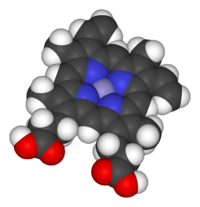
Photo from wikipedia
Abtract Heme binds to amyloid β-peptide (Aβ) in the brain of Alzheimer΄s disease (AD) patients, thus forming heme-Aβ complexes and leading the characteristic pathological features of AD. The heme-Aβ complexes… Click to show full abstract
Abtract Heme binds to amyloid β-peptide (Aβ) in the brain of Alzheimer΄s disease (AD) patients, thus forming heme-Aβ complexes and leading the characteristic pathological features of AD. The heme-Aβ complexes reduce O2 by 2e− to obtain co-reactant H2O2. In this work, two-dimensional graphite-like carbon nitride (g-C3N4) was hybridized with heme via π-π interaction to construct an electrochemiluminescence (ECL) biosensor for detection of Aβ peptides. The capture aptamer was firstly immobilized on the gold electrode, and then incubated with target Aβ peptides and g-C3N4-heme. The g-C3N4-heme-Aβ composite was subsequently anchored on the electrode and showed a signal-on, label-free ECL emission based on dual co-reactants enhancement attributed to in-situ generated H2O2 and original K2S2O8 in PBS buffer. Under the optimum experimental conditions, the ECL biosensor has a sensitive response to Aβ peptides with a linear range of 10 fM-0.1 μM and a detection limit of 3.25 fM. Considering prominent specificity, reproducibility, and stability, the proposed biosensor was used to assess recovery of Aβ peptides in human serum and the result was satisfactory. We believe that the established method would offer a useful analytical means for quantifying Aβ peptides in a biological matrix.
Journal Title: Electrochimica Acta
Year Published: 2020
Link to full text (if available)
Share on Social Media: Sign Up to like & get
recommendations!